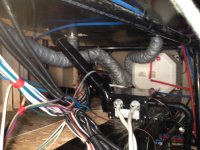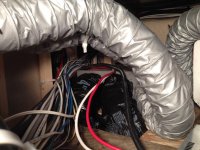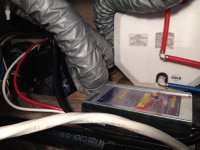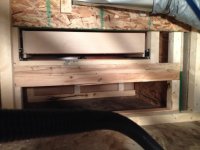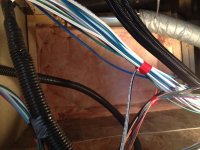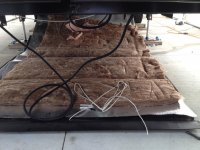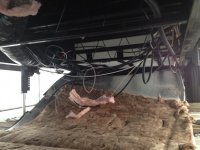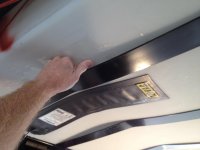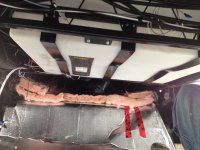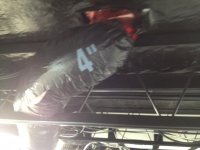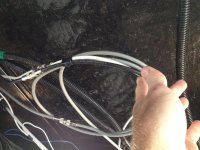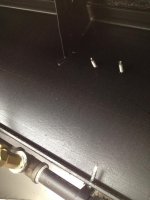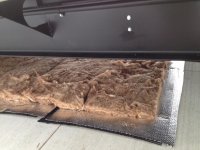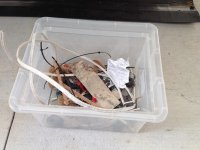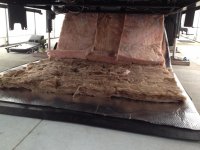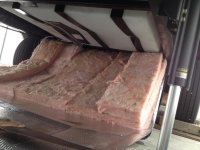adam
Well-known member
Good Evening;
Perhaps some of you were following one of my other threads in the AC electrical forum - this thread is a continuation of that project.
https://heartlandowners.org/showthread.php/47811-Landmark-GFI
If you looked at the other thread you will see I was troubleshooting 2 bothersome electrical issues with my new Landmark. Obviously to facilitate fixing those issues I dropped both the smaller forward belly panel and the larger rear panel. In doing so I discovered that there were a variety of housekeeping items that I could address while the panels were on the ground.
It appears that most of the wiring and plumbing is installed by the manufacturer after the panels and insulation are installed before the flooring goes on the frame. Most items were just laying along their runs. I understand that everything is hidden and somewhat protected by the insulation, but it just didn't seem right to put it back together in the same manner. More importantly I discovered faults that would have eventually reared there ugly heads down the line as we continued to use the coach. Its not my intention to be critical of the build process but I hope that other members can benefit from some of these items that I addressed in the underbelly/basement of our Landmark. These first round of pictures show some of the things that I addressed in the enclosed area behind the basement under the bathroom:
1. I discovered 1 of the hot air feeds to the kitchen from the furnace was not hooked up to the furnace discharge port. I connected this to the furnace.
2. The smaller 2" heat line that goes from the furnace to the underbelly was jammed into the insulation next to the forward grey tank, there was no way it would have provided any heat to the underbelly. I rerouted this small hose to blow clear into the belly.
3. All of the main DC wiring was running along the upper edge of the furnace where I discovered some chaffing on the wire insulation. i reparied the wires and carefully routed the wiring bundle away from the furnace.
4. The hot air supply duct to the bedroom was blocking the cooling fan on the converter. The hose was rerouted.
5. The transfer switch for the generator/shore power had not been screwed to the floor.
6. My wife complained that there was a draft from the stair area, so I insulated this area to stop the draft coming around the stair drawer inside the coach.
7. Other housekeeping items in this area included wire tieing all loose wires and giving the complete area a thorough vacuum.
Thats a start. The underbelly area came next.....
Perhaps some of you were following one of my other threads in the AC electrical forum - this thread is a continuation of that project.
https://heartlandowners.org/showthread.php/47811-Landmark-GFI
If you looked at the other thread you will see I was troubleshooting 2 bothersome electrical issues with my new Landmark. Obviously to facilitate fixing those issues I dropped both the smaller forward belly panel and the larger rear panel. In doing so I discovered that there were a variety of housekeeping items that I could address while the panels were on the ground.
It appears that most of the wiring and plumbing is installed by the manufacturer after the panels and insulation are installed before the flooring goes on the frame. Most items were just laying along their runs. I understand that everything is hidden and somewhat protected by the insulation, but it just didn't seem right to put it back together in the same manner. More importantly I discovered faults that would have eventually reared there ugly heads down the line as we continued to use the coach. Its not my intention to be critical of the build process but I hope that other members can benefit from some of these items that I addressed in the underbelly/basement of our Landmark. These first round of pictures show some of the things that I addressed in the enclosed area behind the basement under the bathroom:
1. I discovered 1 of the hot air feeds to the kitchen from the furnace was not hooked up to the furnace discharge port. I connected this to the furnace.
2. The smaller 2" heat line that goes from the furnace to the underbelly was jammed into the insulation next to the forward grey tank, there was no way it would have provided any heat to the underbelly. I rerouted this small hose to blow clear into the belly.
3. All of the main DC wiring was running along the upper edge of the furnace where I discovered some chaffing on the wire insulation. i reparied the wires and carefully routed the wiring bundle away from the furnace.
4. The hot air supply duct to the bedroom was blocking the cooling fan on the converter. The hose was rerouted.
5. The transfer switch for the generator/shore power had not been screwed to the floor.
6. My wife complained that there was a draft from the stair area, so I insulated this area to stop the draft coming around the stair drawer inside the coach.
7. Other housekeeping items in this area included wire tieing all loose wires and giving the complete area a thorough vacuum.
Thats a start. The underbelly area came next.....
Attachments
Last edited:

